
50 IDEAS
FOR MORE
ACCESSIBLE
ELECTIONS
October 2012
Foreword
The Information Technology and Innovation
Foundation (ITIF) received a grant from the U.S.
Election Assistance Commission (EAC) to improve
the accessibility of elections for voters with
disabilities. As part of this effort we partnered with
OpenIDEO to hold a public design challenge
around the question, “How might we design an
accessible election experience for everyone?” We
also held two design workshops where we brought
together a diverse group of stakeholders,
including voting technology vendors, security
experts, election officials, people with disabilities,
accessibility advocates, designers, and
researchers from various fields, to work together
to generate concepts that could help make the
voting process more accessible.
This report highlights fifty ideas, both big and
small, that were generated during this process.
Some of these ideas have already been
implemented in a few elections and represent
emerging best practices; others are still in the
early design phase. Our hope is that these ideas
will spur others to continue to innovate and pursue
new ways of making elections more accessible for
all Americans.
Daniel Castro
Project Director
ITIF Accessible Voting Technology Initiative
50 Ideas for More Accessible Elections
1. Virtual “I Voted!” stickers
2. Preferences on voter registration forms
3. A genius bar for voting
4. Easy-to-adjust voting systems screens
5. A “Yelp” for polling places
6. Voter communication profiles
7. Online poll place accessibility information
8. An easier-to-grip smartcard
9. Vote-pools
10. Schedule a mobility tour
11. Hire people with disabilities as poll workers
12. Make online forms fully accessible
13. Easy to read election information
14. Drive-through voting
15. Mobile-friendly election web sites
16. Add captions to videos
17. Election kiosks in care facilities
18. Ready-to-vote toolkit
19. See. Click. Fix.
20. Self-assessment tools to check election accessibility
21. Interactive voter’s guide
22. Voter assistants
23. Reminders for voters
24. Use familiar technology for voting
25. Learn a few signs
50 Ideas for More Accessible Elections
26. Mark ballots anywhere
27. Accessibility advice app
28. Use QR codes to enter long URLs
29. A voter help hub
30. Interactive guide to prepare to vote
31. Crowdsource subtitles for videos
32. Online wait times
33. Use students as poll workers
34. Create a virtual suggestion box
35. Voting vans
36. Polling place accessibility map
37. Better signage
38. An innovators network for poll workers
39. Open election information
40. Online poll worker training
41. Community voter advocates
42. Disperse the queue
43. Pop-up polling places
44. Mail an absentee voting device
45. Tell a story. Enact a scene.
46. Barcodes to transfer voting choices
47. Standards for assistive devices
48. Tap it to configure it
49. Simplify the interaction
50. Preferences on voter registration cards
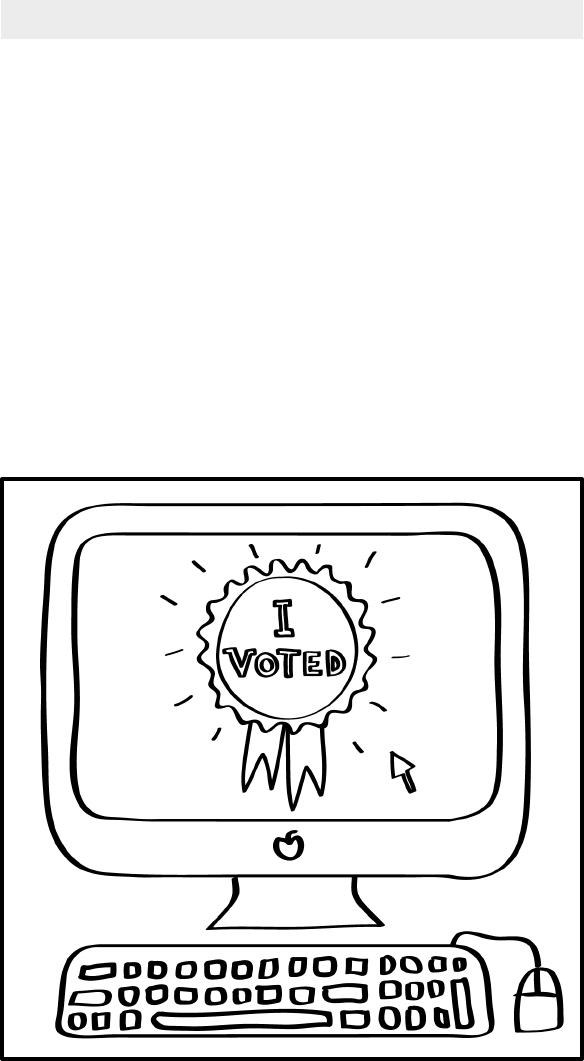
1. Virtual “I Voted!” stickers
Problem: “I voted” stickers remind friends and neighbors
to vote, but they are not accessible for everyone,
especially voters with vision disabilities or those who
vote absentee from home.
Idea: Remind voters that they can declare themselves to
be voters online, using social networks and mobile apps
like Facebook and Foursquare that allow voters to “check
in” to polling places.

2. Preferences on voter registration
forms
Problem: Since election officials do not always have
good information about their voters’ specific needs and
preferences, they do not always send voters information
in the most accessible format for them.
Idea: Election officials could allow voters to indicate on
their voter registration forms their preferences, such as
using a large print or non-English language ballot, so poll
workers can be better prepared on Election Day.
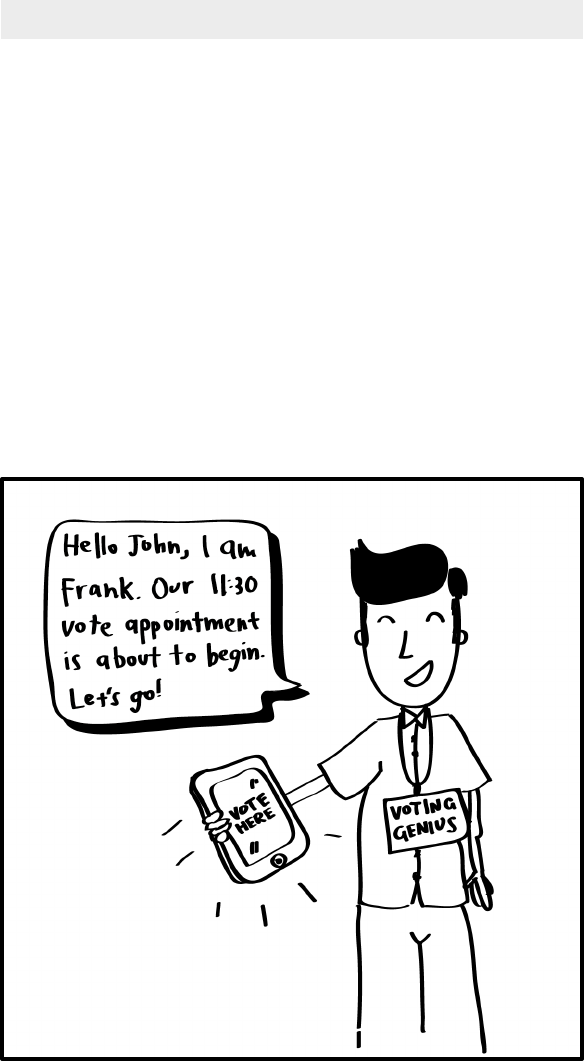
3. A genius bar for voting
Problem: Some voters need a little extra assistance,
attention, time or flexibility to meet their voting needs.
Idea: What if going to the polls could be like making an
appointment at an Apple Genius Bar where poll workers
could act as “voter service agents?” At the polling place,
someone could be ready to help and focused on making
sure the voter is able to vote successfully.
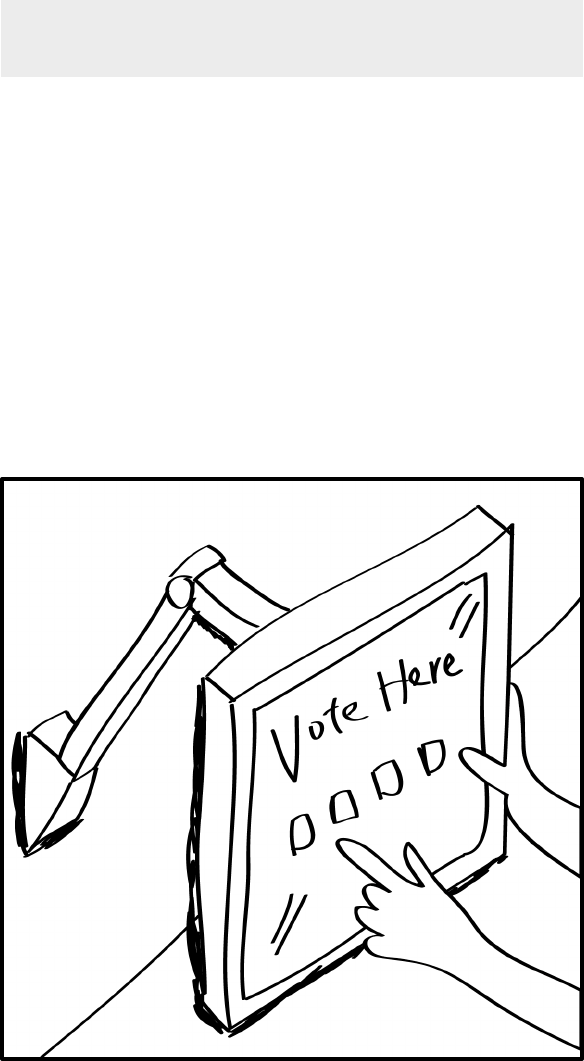
4. Easy-to-adjust voting systems
screens
Problem: Since there are different kinds of wheelchairs,
technologies, and physical abilities to consider, some
voting systems may not put the ballot directly in front of
the voter.
Idea: A simple, safe, easy-to-adjust mounting arm could
make voting systems more accessible by placing the
screen in the right place for each voter. These are
commercially available at a low cost.
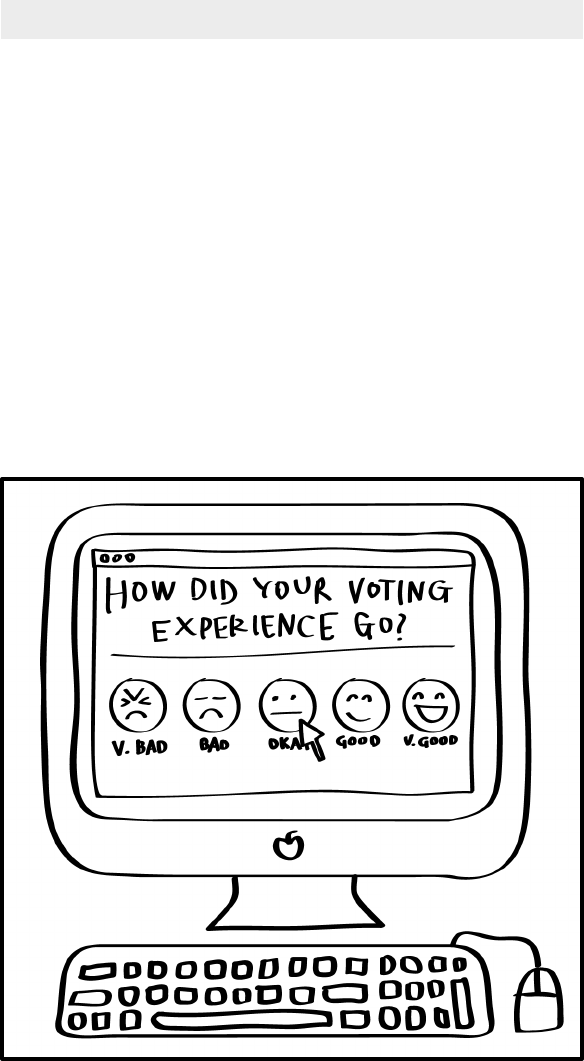
5. A “Yelp” for polling places
Problem: Election officials do not always receive a lot of
feedback on how well a polling place is run, especially in
big districts with many polling places.
Idea: An online rating system could allow voters to give
feedback to election officials on what is, or is not,
working and how to improve the voting experience.
Ratings for polling places could help voters identify the
most accessible early voting centers and well-run polling
places. This would also let the community recognize the
expertise of election officials who operate the best
polling places, who can then help improve neighboring
locations.
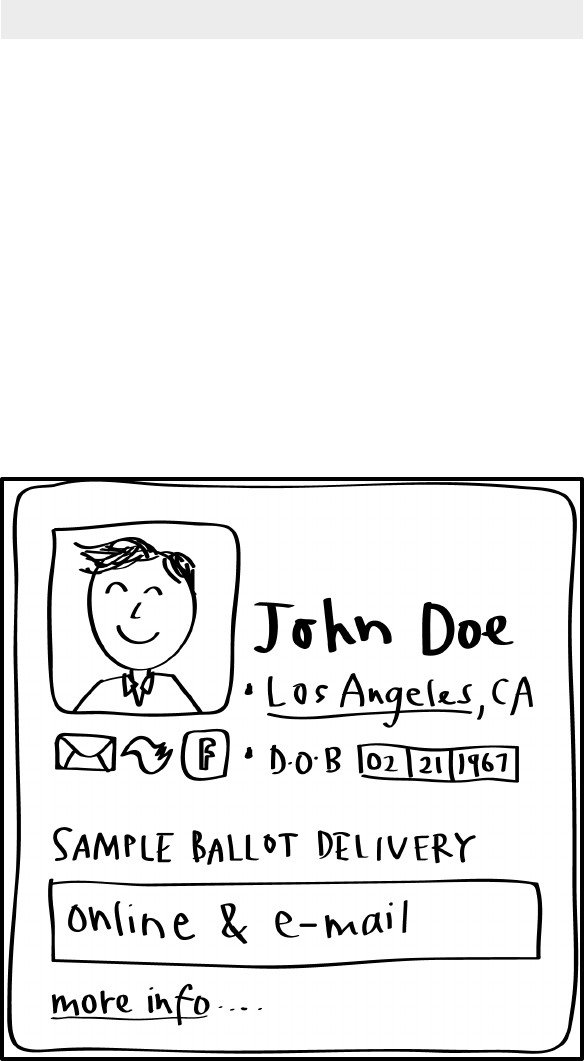
6. Voter communication profiles
Problem: Some voters receive election information in the
mail that they cannot read, because they have a print
disability or because the information is in a language
they do not read well.
Idea: Election officials could let voters create a profile to
list their preferences for receiving election-related
information, such as how they want their sample ballots
and election notices delivered. Voters could setup and
update their profiles in a variety of ways—online, by
phone, through the mail, or in person—for the widest
accessibility.
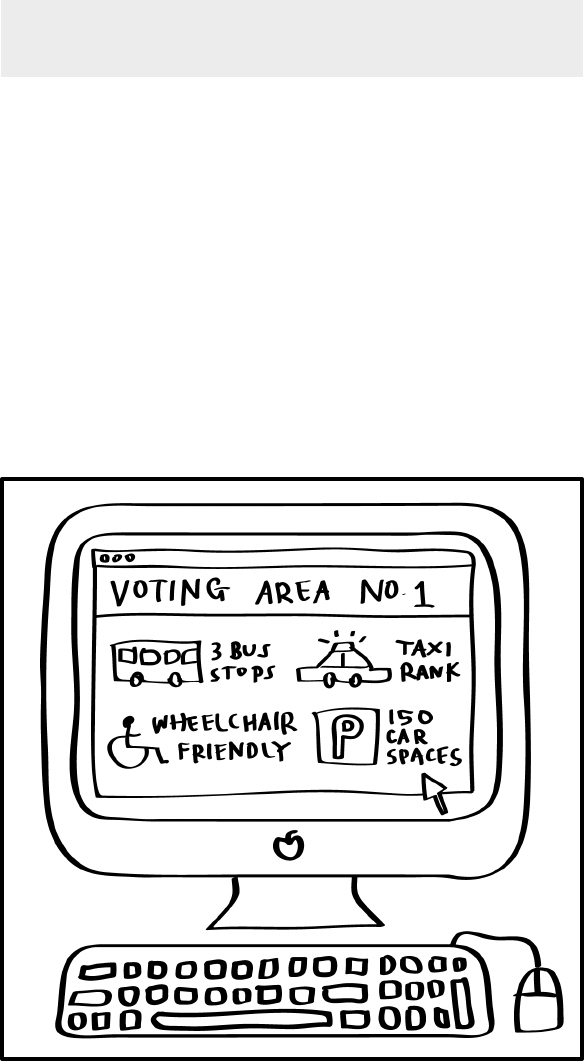
7. Online poll place accessibility
information
Problem: Voters with disabilities may not go to a polling
place if they do not know what accessibility options are
available to them before they get there.
Idea: State and local election websites could include
accessibility information, such as where to park, photos
of poll places, and the nearest public transportation
options, to help raise awareness about the options
available to voters.
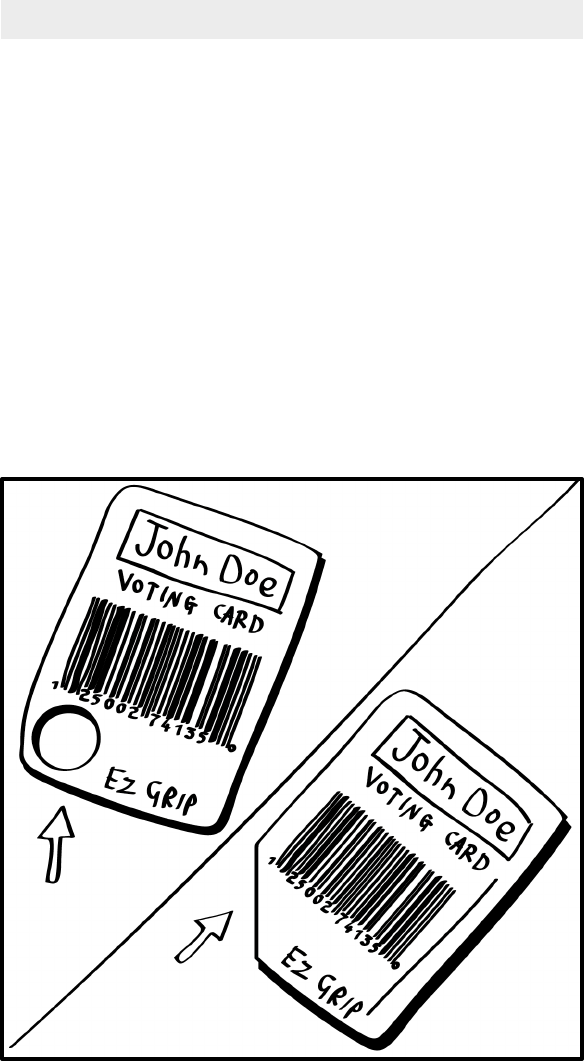
8. An easier-to-grip smartcard
Problem: Some voting systems are activated with smooth,
flat, plastic smartcards, but they can be hard for voters
with arthritis or low dexterity to hold, and inserting them
in the right direction is a challenge for blind voters.
Idea: Election officials could add a hole for a finger grip
and cut an angle off of one corner or add a notch in the
bottom for orientation to make these plastic cards more
accessible.
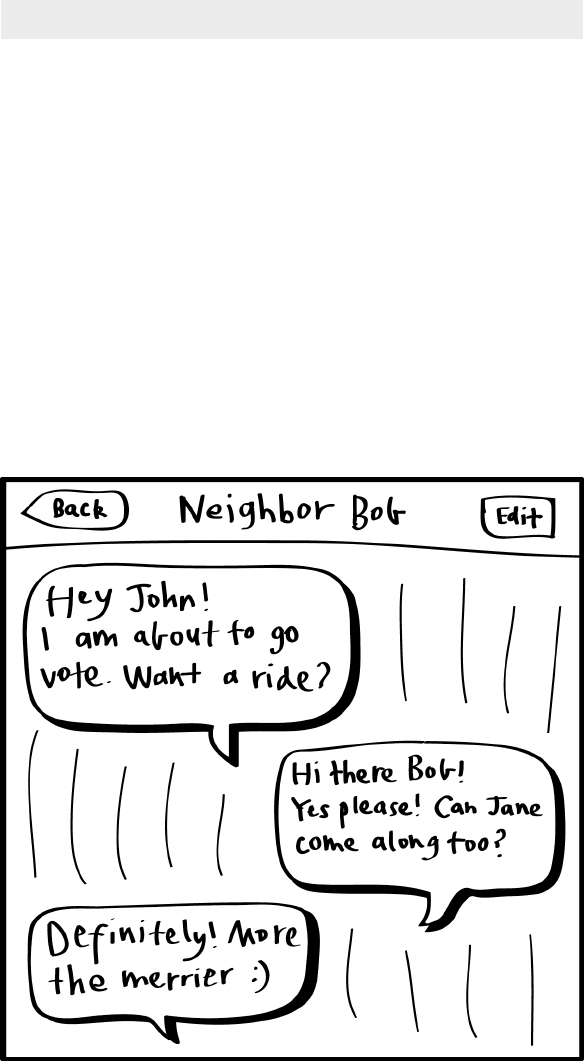
9. Vote-pools
Problem: For many people, just getting to their polling
place is inconvenient, difficult, or time-consuming,
especially if they have to rely on public transportation.
Idea: Car pools let drivers in the community help their
neighbors get to the polling place. Voters could use new
online tools such as Ridejoy and Rideshare, which use
text messaging and microblogging services to help make
car pools fast and easy.
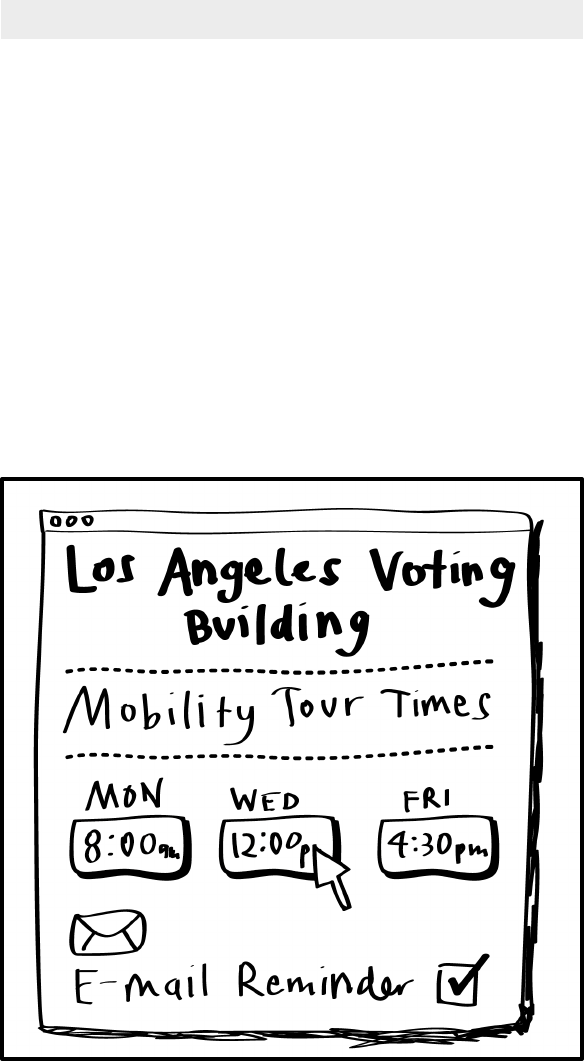
10. Schedule a mobility tour
Problem: Voters who use wheelchairs, crutches or canes
and voters with visual disabilities may have problems
navigating an unfamiliar place or one with obstructions.
Election officials may not be aware of all the things that
can make a space inaccessible.
Idea: Election officials could set up a time for voters who
use wheelchairs, scooters, or walkers, and other voters
with disabilities to have a mobility tour through polling
places and show poll workers how they experience the
space. This could allow everyone to learn about the small
things that can improve the accessibility of rooms and
buildings.
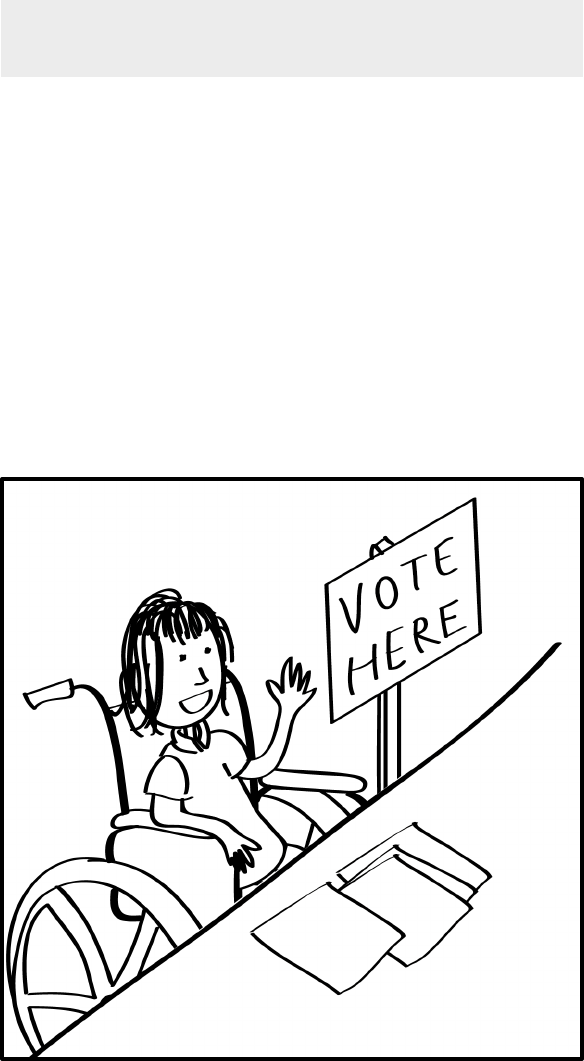
11. Hire people with disabilities as poll
workers
Problem: Poll workers and election staff want to help, but
they may not have much first-hand experience interacting
with people with a variety of disabilities.
Idea: Election officials could make people with
disabilities part of the solution by including more of them
as poll workers. This would raise the “Accessibility IQ”
at election departments, put experts in the polling places,
and let staff and other poll workers learn by example.
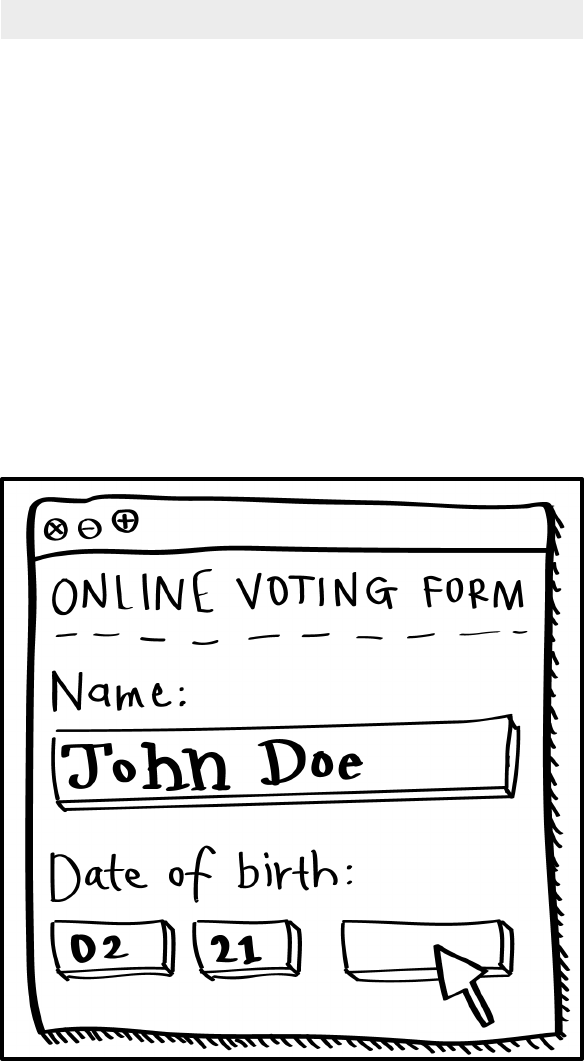
12. Make online forms fully accessible
Problem: Paper forms are totally inaccessible for many
voters, including those with vision and dexterity
disabilities.
Idea: Election officials should make sure that all forms,
including voter registration forms and absentee ballot
request forms, are available online and follow
accessibility best practices. In addition, voters should be
able to complete and submit all forms online.

13. Easy to read election information
Problem: For voters who do not read well, election
information can seem like a jumble of words. As a result,
these individuals may be embarrassed to vote.
Idea: If election officials put information online, this
could allow voters to read the information ahead of time
or use tools on their computer to change the appearance
of the text to make it easier to read. Election officials
should ensure that information is provided in plain
language, using everyday words for election concepts.
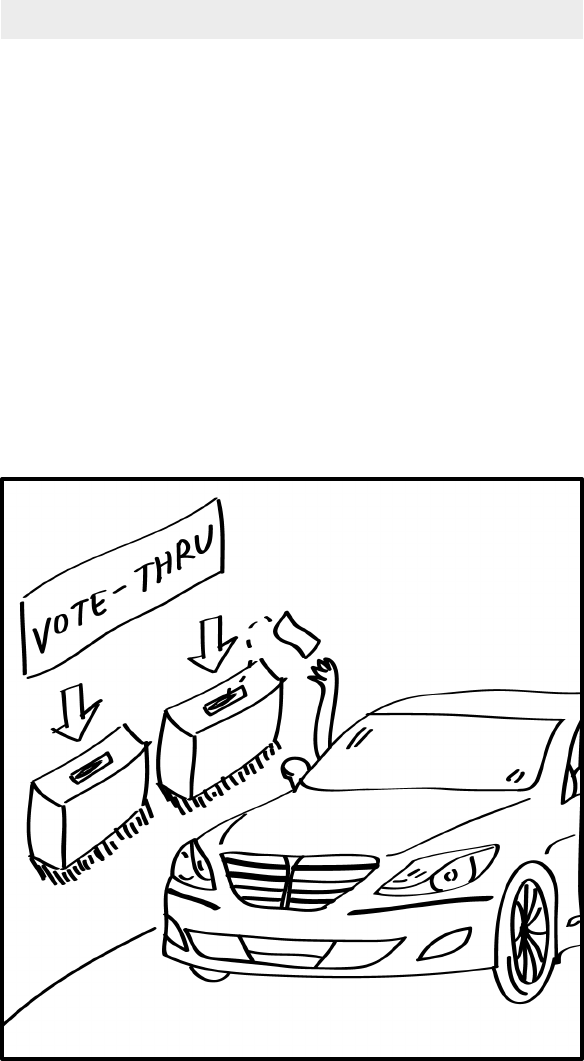
14. Drive-through voting
Problem: When drop boxes for postal voting and
absentee ballots are not easy to get to, because they are
across a sidewalk from the curb or inside a building, it
makes it hard for voters with mobility disabilities to
deposit their ballots.
Idea: Election officials could use a drive-through drop-off
location, much like we use for fast food, pharmacies, and
banks, to make it easier to return ballots. This eliminates
the need to search for a place to park or force voters to
navigate a new—and potentially inaccessible—building.
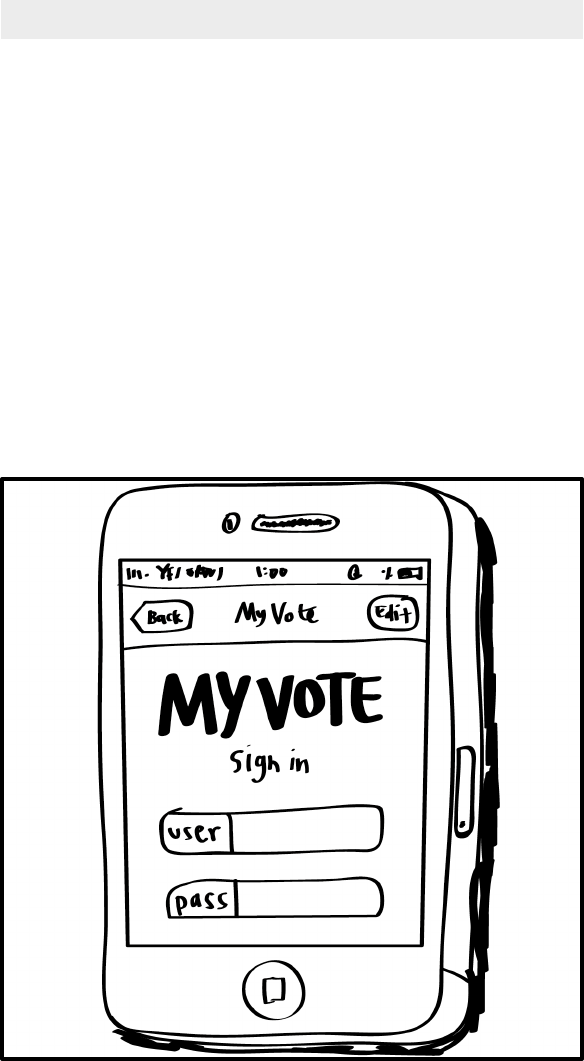
15. Mobile-friendly election web sites
Problem: For people with disabilities, smartphones can
be a lifeline, but election web sites do not always work
well on a small mobile device screen. This can keep
voters who rely on their phone as their main computer
from finding election information.
Idea: Election officials should make sure that election
web sites and applications, like online voter registration,
work on mobile devices, either with a mobile app or a
website designed so that it automatically adapts to the
size of the screen. One way to help ensure that forms and
web sites work on smartphones is to keep the layout
simple.

16. Add captions to videos
Problem: Videos are a great way to provide voter
education online, but without captions they are not
accessible for people with a hearing disability, people
learning English, or people in a noisy environment.
Idea: Captioning used to be difficult, but new tools on
platforms like YouTube now make adding subtitles easier
than ever. Election officials could choose video services
that support captions for accessibility and add subtitles
and captions to all videos to make them universally
accessible.
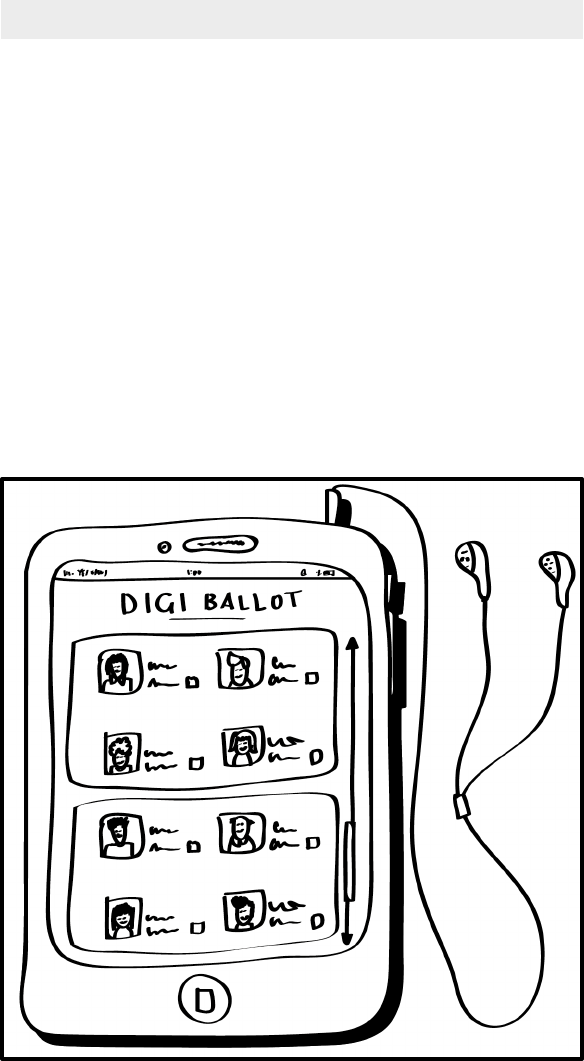
17. Election kiosks in care facilities
Problem: For people in hospitals, nursing homes, and
assisted living facilities, learning about elections and
getting to a polling place or early voting center can be a
challenge because they may be unable to easily leave the
facility.
Idea: Using lightweight, portable devices like iPads to
allow voters to view and mark their ballots could make it
easier for election officials to provide supervised voting
in care facilities. These devices could be used both as a
kiosk and as a portable voting device.

18. Ready-to-vote toolkit
Problem: It can be difficult for voters to find all the
information about how to vote, such as election dates,
options for where to vote, how the voting systems works,
and what is on the ballot. This problem can be especially
acute for voters who have trouble using the Internet.
Idea: Election officials could create a “ready-to-vote”
toolkit to bring together all the information a voter needs,
with information in print, audio, video, Braille, and
access to a hotline all in one package. These kits could
be distributed directly to voters or made available to
groups and facilities that support voters with disabilities.
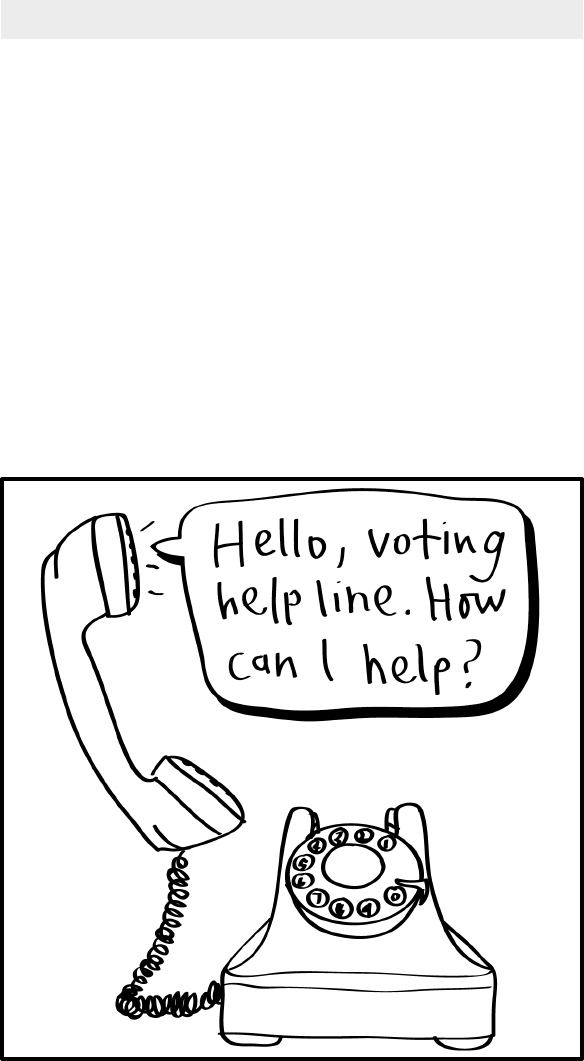
19. See. Click. Fix.
Problem: If a voter sees a problem that cannot be resolve
at a polling place, they may not know how to report it and
get it fixed. Fixing these problems is particularly
important if it is keeping voters from participating in an
election.
Idea: Hotlines like 311 and websites like “See. Click.
Fix.” let people connect to their local government. These
types of communication platforms could give voters the
same opportunity to quickly report problems to election
officials for immediate resolution.

20. Self-assessment tools to check
election accessibility
Problem: Election officials and individuals at non-profits
who provide election support services may not know how
to make sure that all people with disabilities can
participate equally in elections when they are first
learning about accessibility.
Idea: Self-assessment tools like the Cambridge Exclusion
Calculator provide useful guidelines that could help
election officials walk through all the election processes
and their materials to check them for accessibility. Using
these tools could help ensure that the overall process is
inclusive.

21. Interactive voter’s guide
Problem: With so much information on some ballots,
some voters may experience information overload,
especially if the information about the different offices,
candidates, and ballot propositions has to be collected
from many different sources.
Idea: An online interactive voter’s guide could bring
together all of this information in one place. For example,
the voter’s guide could include a sample ballot,
descriptions of each office, and explanations of ballot
questions. Voters could then use their own devices and
assistive technology to research their options and bring a
completed sample ballot with them to the polling place.

22. Voter assistants
Problem: Voters using absentee ballots sometimes need
assistance outside of normal business hours.
Idea: A network of volunteers could make information
available even when the election office is closed.
Election officials can consider how, with some training,
volunteers on social networks may be able to be part of
the official channel of information to the public. This
network could also connect experts in assistive
technology to the voters who need help.

23. Reminders for voters
Problem: Voters, especially those with cognitive
disabilities, may need a reminder to go vote.
Idea: Automated reminders, via phone, text or email, can
help remind voters when it is time to request an absentee
ballot or go vote. TurboVote is an online program that
helps make it easy to register to vote and then get
reminders as Election Day approaches. This type of
program may be especially useful for voters in long-term
care facilities and veterans with traumatic brain injury
(TBI) or post-traumatic stress disorder (PTSD).
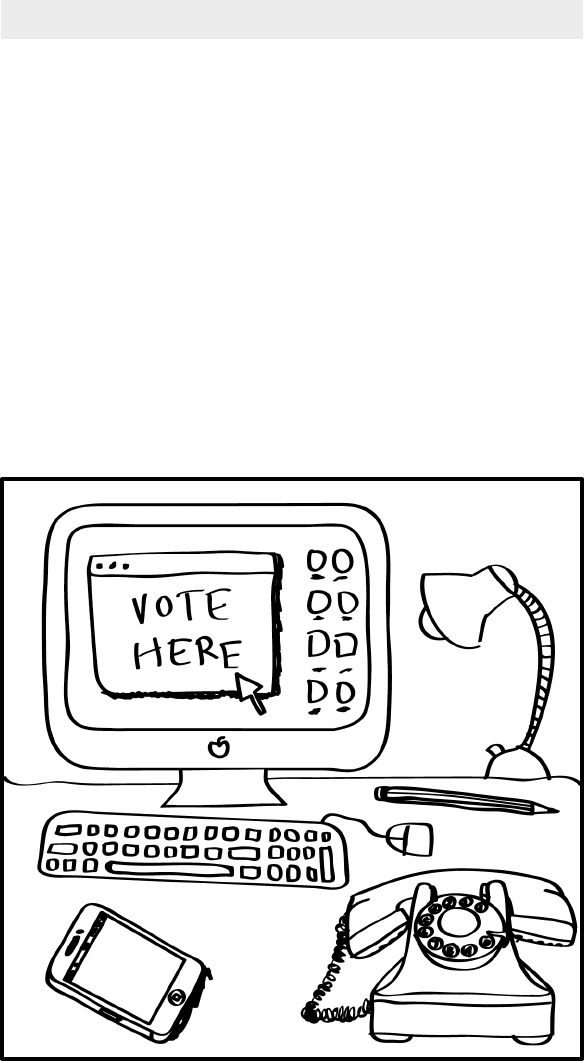
24. Use familiar technology for voting
Problem: Dedicated voting systems can be confusing for
voters who use assistive technology, like screen readers,
or who do not learn new things quickly.
Idea: Election officials and voting system designers could
continue to explore how to allow voters to use familiar
technologies, such as phones, ATMs, and televisions, as
part of elections.
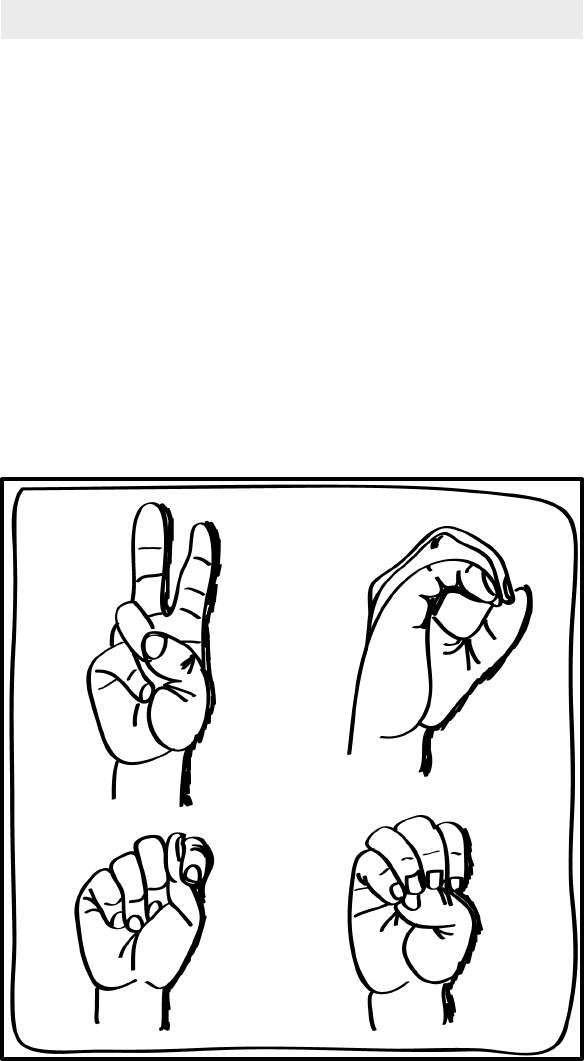
25. Learn a few signs
Problem: Some deaf voters rely on American Sign
Language (ASL) to communicate and do not read English
easily.
Idea: Election officials may not be able to become fluent
in ASL, but adding sign interpretation to videos could
make elections more accessible for some voters.
Researchers
are also creating software to automatically
create ASL videos in which animated people sign phrases
and sentences. Election officials could create a glossary
of words and phrases to explain elections to ASL-
speakers. This resource could be useful in the polling
place to provide voter assistance using a mobile device.
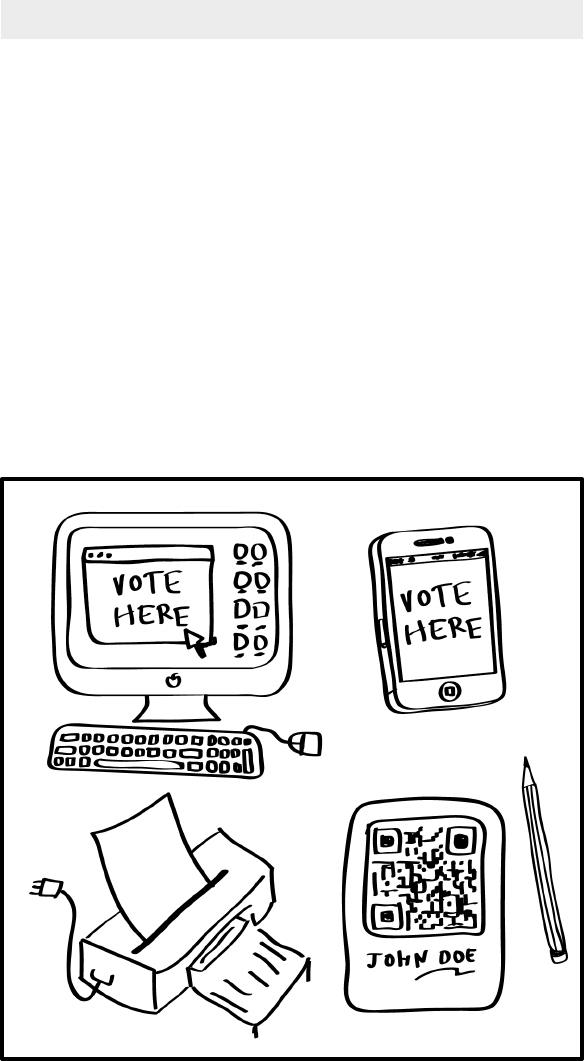
26. Mark ballots anywhere
Problem: Polling places can be difficult environments for
people with cognitive or attention-related disabilities
because they are crowded, noisy and unfamiliar—all
situations that people with these disabilities cannot cope
with well or which can trigger panic.
Ideas: Voting systems could be designed so that marking
a ballot and casting a ballot are two distinct processes.
Voters could mark their ballots before coming to the
polling place in the comfort and privacy of their own
environment with familiar assistive technology. Voters
would then submit their votes at a polling place when
they cast their ballot.

27. Accessibility advice app
Problem: Poll workers may not know what support to
offer voters, especially if their disability is invisible, and
voters may not know what assistance is available to
request.
Idea: A simple form or mobile app could help quickly
suggest the best option for each voter. The poll worker or
voters could enter a few details about their needs, and
then be shown the accessibility options available at their
polling place. This would eliminate guessing or the need
to engage in a public conversation to figure out what will
help the person vote.
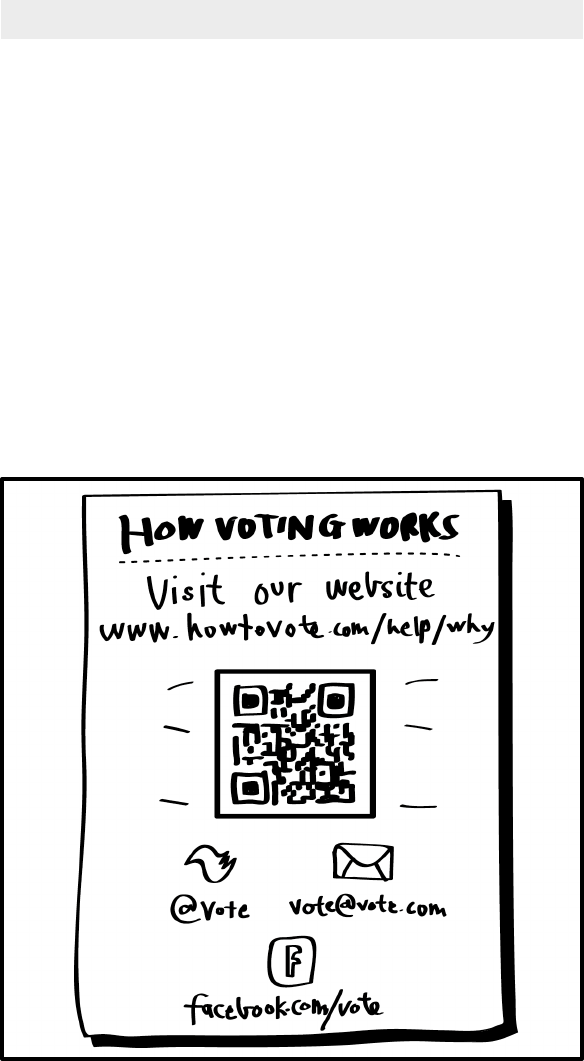
28. Use QR codes to enter long URLs
Problem: The website address for the local election
office may be too long to remember or easily type,
especially if it is displayed on a sign or other printed
materials. For voters with visual or cognitive disabilities,
transferring information from one form to another can be
difficult.
Idea: Election offices could include a QR code on all of
their signs and mailings so that individuals can scan the
barcode with their mobile device and get to the official
website quickly and easily, without having to type in a
long URL. For example, a poster for voter registration can
take users directly to the online registration form.

29. A voter help hub
Problem: Voters who need help cannot easily find people
who are willing to provide help in their communities.
Idea: An online social network act could act as a hub to
connect, alert, and coordinate volunteers in a community.
For example, a voter who needs assistance might find that
others in the community are willing to provide assistance
voting, if they only knew of the need.
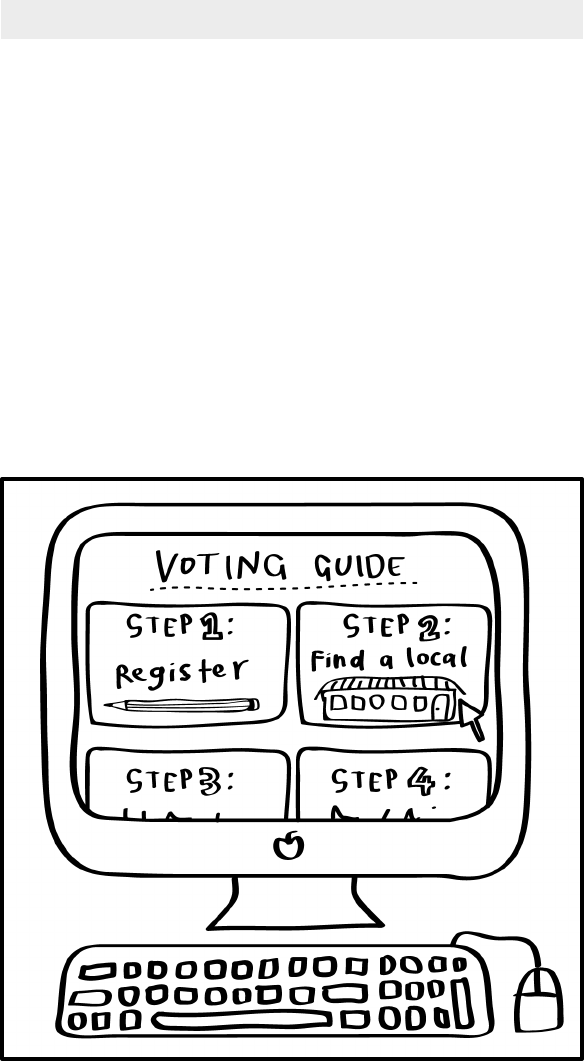
30. Interactive guide to prepare to vote
Problem: Getting ready to vote starts long before Election
Day and requires voters to make sure they are registered
to vote, learn when and where they can vote, and decide
whether they will vote in-person or absentee. Some voters
with cognitive disabilities may have difficulty
remembering all of these steps and keeping track of their
plans and progress.
Idea: An interactive online system or mobile app could
help guide voters through this process. For example, this
could include a checklist with deadlines that tells voters
what steps they need to complete to be able to vote and
allows voters to take notes and mark their progress.
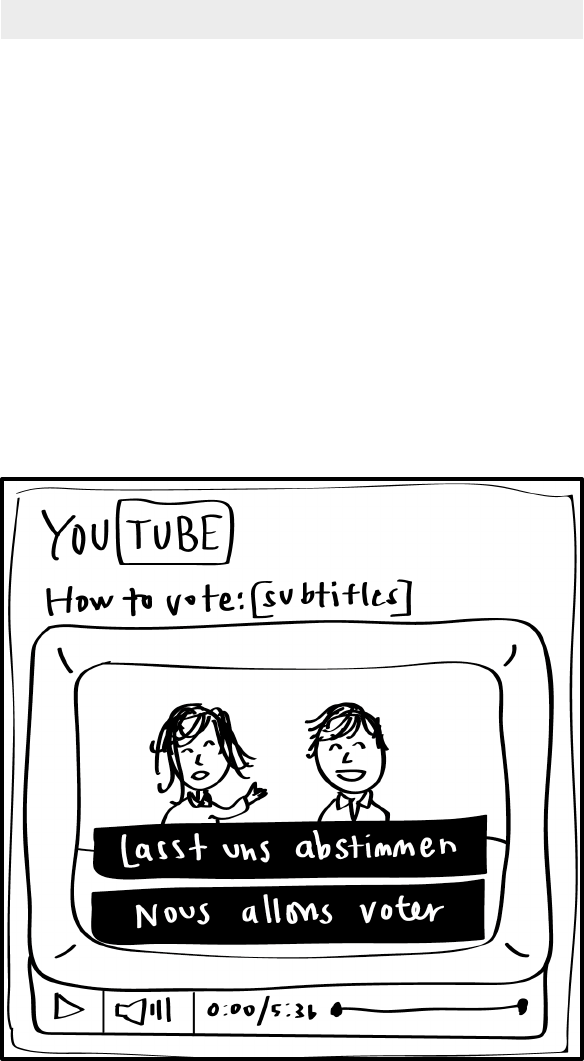
31. Crowdsource subtitles for videos
Problem: Election departments use video to provide
information and voter education; however, these videos
are not always provided in other languages.
Idea: One way to get election videos translated and
subtitled in different languages might be directly from the
community. Election officials could work with community
organizations or individual volunteers to crowdsource
captions using open source tools like Amara. Providing
transcripts of the videos is also helpful for many voters
and makes it easier for search engines to find the videos.

32. Online wait times
Problem: The long wait at polling places may discourage
people from voting.
Idea: Sometimes voters can avoid these lines by voting
earlier or later in the day. If election officials post wait
times online, then voters could better decide when to vote
or go to a less crowded polling place if that is allowed,
such as during early voting periods.
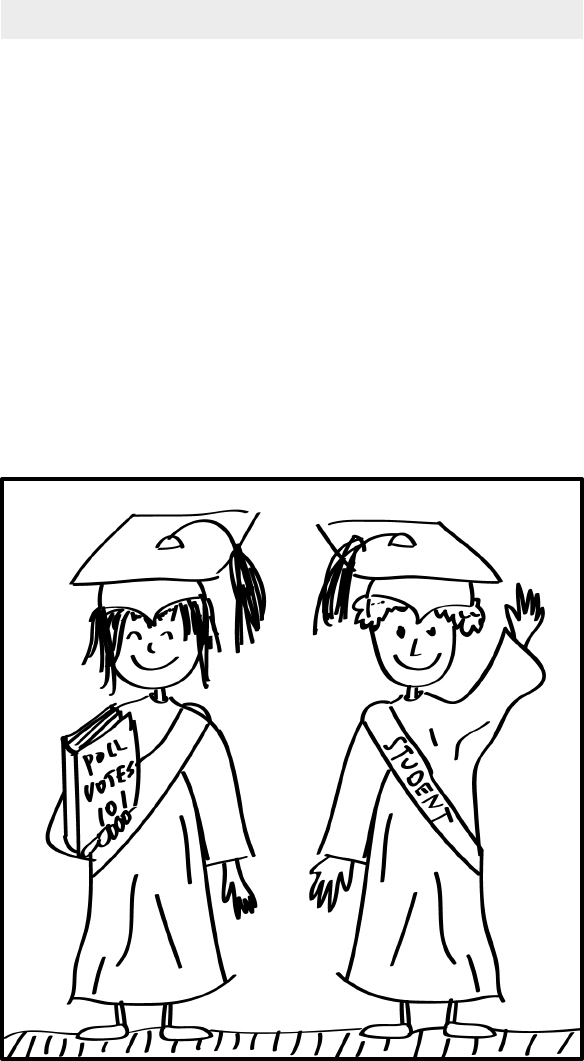
33. Use students as poll workers
Problem: Many election departments struggle to find
enough poll workers.
Idea: Election officials could recruit and train students in
high school to work as poll workers in elections in their
communities. Polling places are often in schools, making
an easy connection. Younger poll workers may be more
familiar with new technologies and can help other poll
workers. By starting early, these students might make
being a poll worker a lifelong habit.
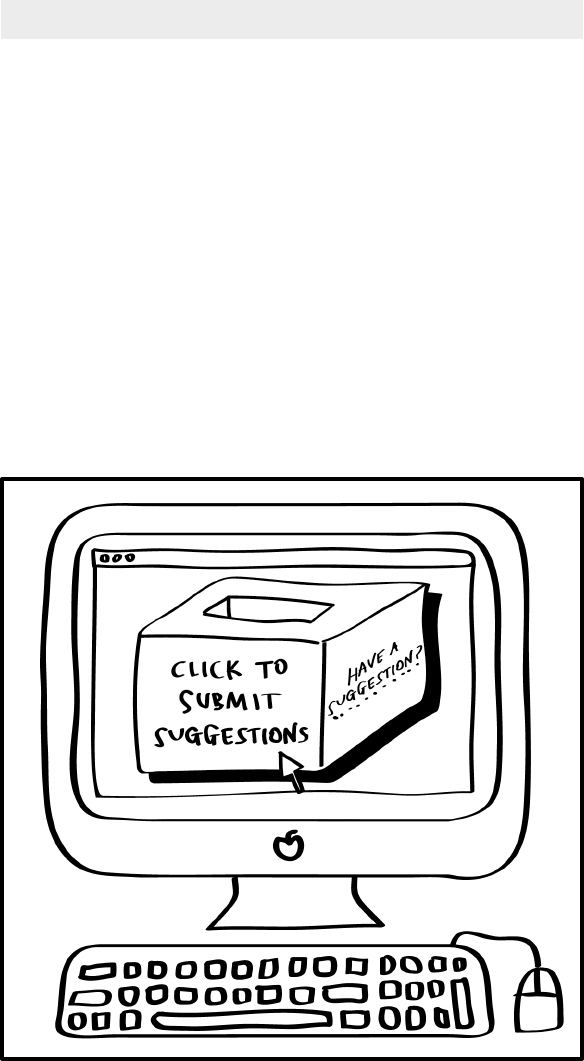
34. Create a virtual suggestion box
Problem: Some election officials are unsure about how to
make a polling place, or other election administration
functions, more accessible.
Idea: Voters with disabilities often have ideas about how
to make their polling place more accessible. Election
officials should allow voters to easily give feedback to
election officials at the polling place or online. An open
discussion of problems and solutions can also increase
transparency and accountability.
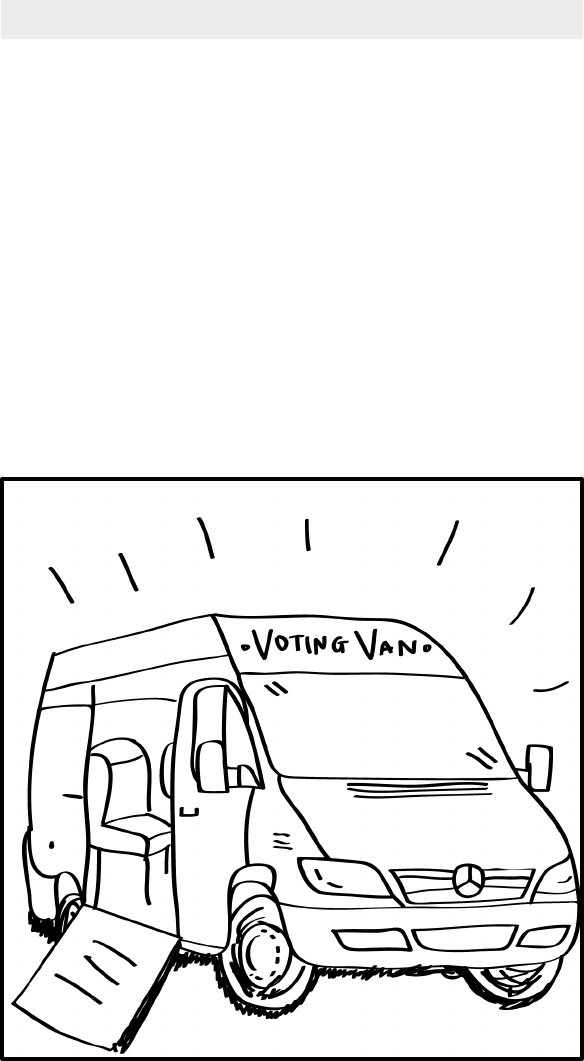
35. Voting vans
Problem: Some voters have trouble getting to the polling
place because they do not have good transportation
options or are home-bound. This can be a particular
problem for people in assisted living facilities, nursing
homes, or rural communities without good public
transportation options for people with disabilities.
Idea: Election officials could take the polling place to
these voters by using a voting van. A voting van could go
into neighborhoods to register voters, run education
sessions, and serve as a mobile polling place. Vans could
make scheduled stops at hospitals and rehab centers to
allow people there to participate in the voting process.
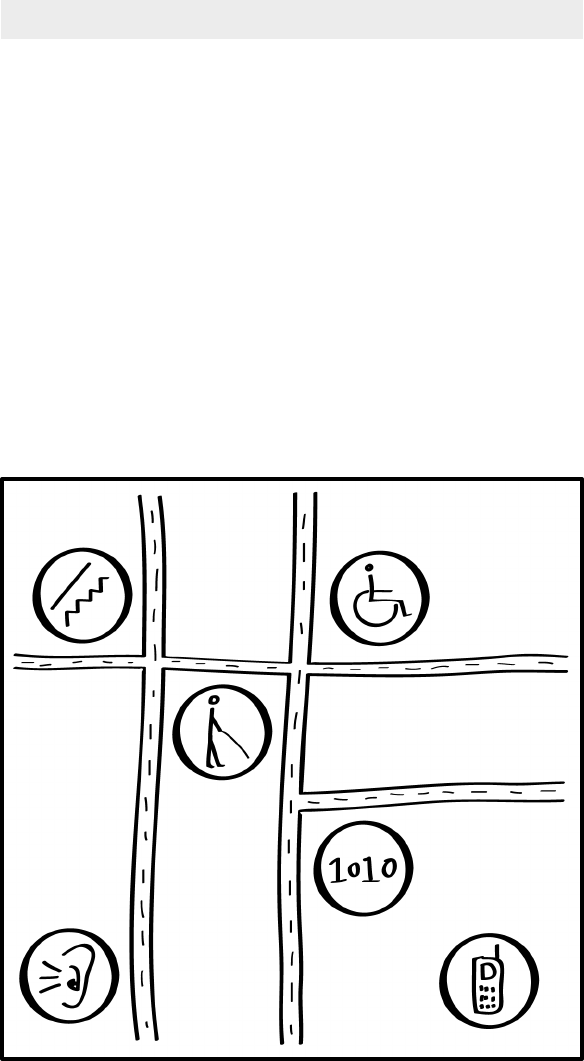
36. Polling place accessibility map
Problem: Voters may not know about the accessible
voting options in their communities, especially for those
who live in communities with in-person early voting or
Election Day voting centers that can handle voters from
different election districts.
Idea: Placing maps of accessible voting centers in the
community, such as at bus and subway stations, could
raise awareness about the options available to voters and
help voters find the accessible voting center most
convenient to them.
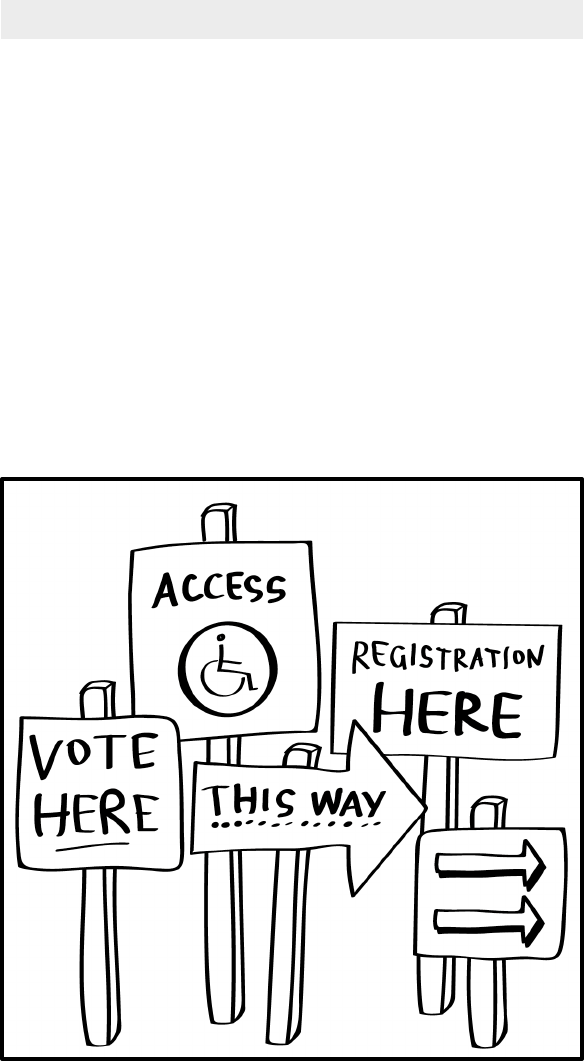
37. Better signage
Problem: If voters cannot see directional signs easily and
from a distance, they can be frustrated trying to enter the
polling place, especially if there is a separate accessible
entrance. When mobility is difficult, extra steps to get to
the right place are an added penalty.
Idea: Election officials should ensure that signs are
visible from a distance. Signs should show where
accessible entrances are located, where to go once
inside, and where to sit for those who need to rest. Better
signs help everyone and improve the flow of traffic in the
polling place.
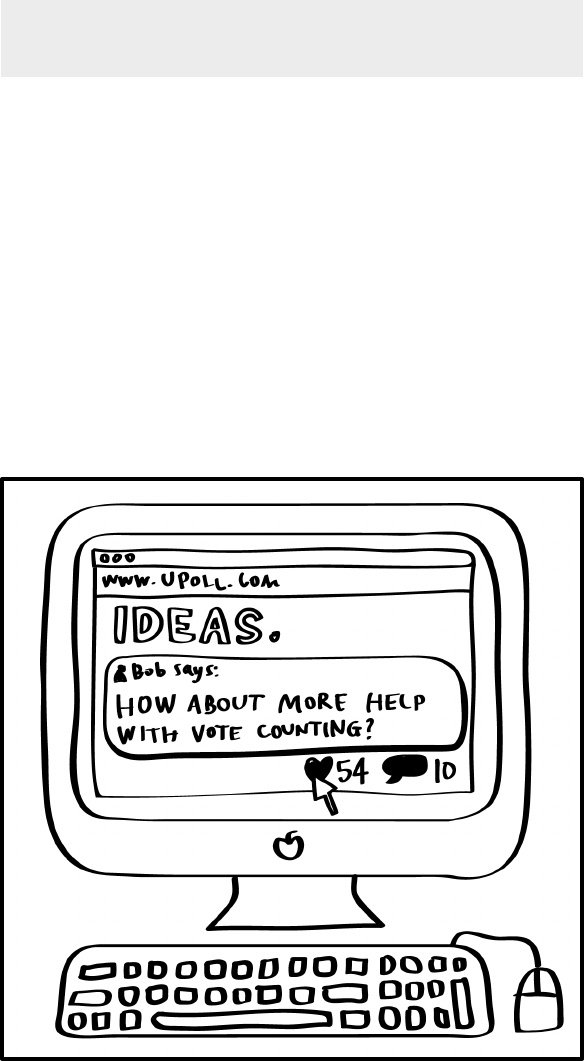
38. An innovators network for poll
workers
Problem: Poll workers discover many good ideas for
making elections more accessible, but these ideas are
not always adopted in other locations.
Idea: Creating a robust innovators network can
encourage poll workers and other election officials to
share new ideas, tips, advice, tools, and knowledge on
how to better run elections and incorporate these ideas
into training and election administration. By connecting
colleagues from different communities, ideas can be
tested in many different situations and refined over time.
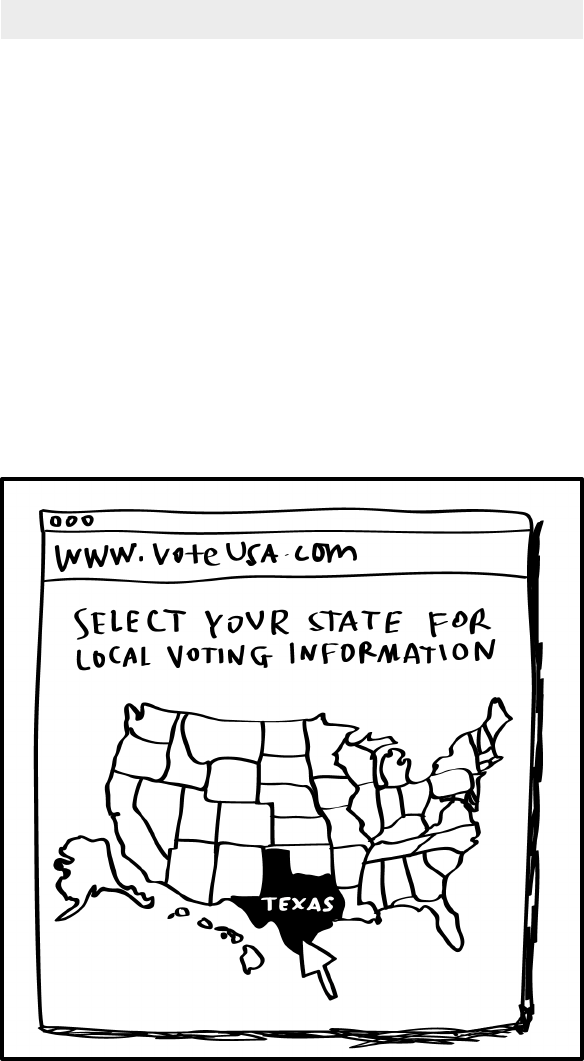
39. Open election information
Problem: Election information can be difficult to find,
especially for caregivers who help many individuals vote
absentee from different counties or states.
Idea: Finding information about voting would be much
easier if voting portals were more consistent. State and
local election officials can make sure they provide
election information in an open, reusable, machine-
readable format. And the federal government can create
vote.gov—a centralized, citizen-focused website with
voter information so that there is a one-stop-shop for
everything related to voting.
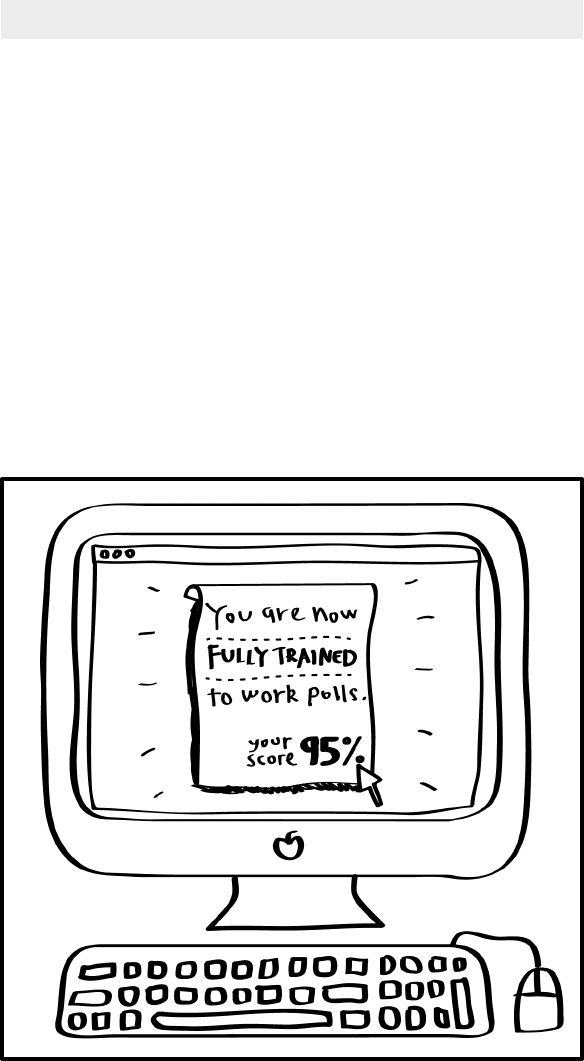
40. Online poll worker training
Problem: The quality of poll worker training varies from
state to state. Without good training, poll workers may be
unable to effectively assist voters with disabilities.
Idea: Rather than have each state create its own training
materials, state and local election offices could pool their
resources to create a standardized online training
platform for poll workers. This would help lower training
costs and ensure that all poll workers receive basic
training on how to work with people with different
disabilities. Election officials could supplement this with
training for specific issues in their state.

41. Community voter advocates
Problem: Election departments have limited resources for
voter education and outreach, and most do not have the
staff to make sure that every voter has access to correct,
authoritative information.
Idea: Election officials could tap people already serving
specific communities, such as health workers, teachers,
social workers, religious leaders, and shopkeepers, to be
part of the voter support team. Election officials can train
these individuals to act as community voter advocates.
These advocates can answer questions, provide
information related to access, and supply official forms.
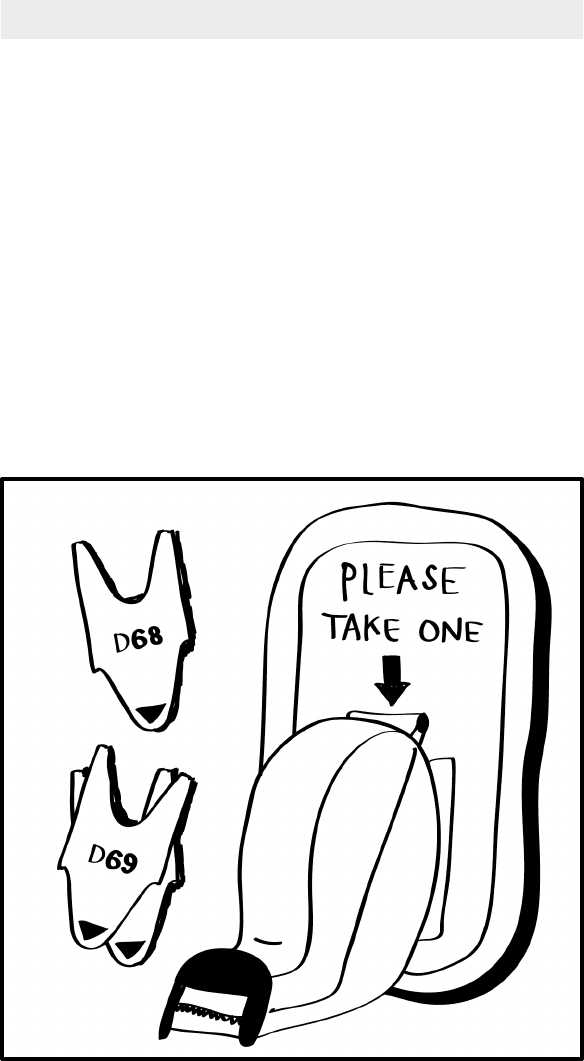
42. Disperse the queue
Problem: Long lines at polling places can be a problem
for people who have trouble standing for long periods of
time, are carrying packages, or have children with them.
Idea: Busy poll places could use “take a number”
machines and seating areas to make the polling place
more comfortable and improve the flow of people through
the voting process.
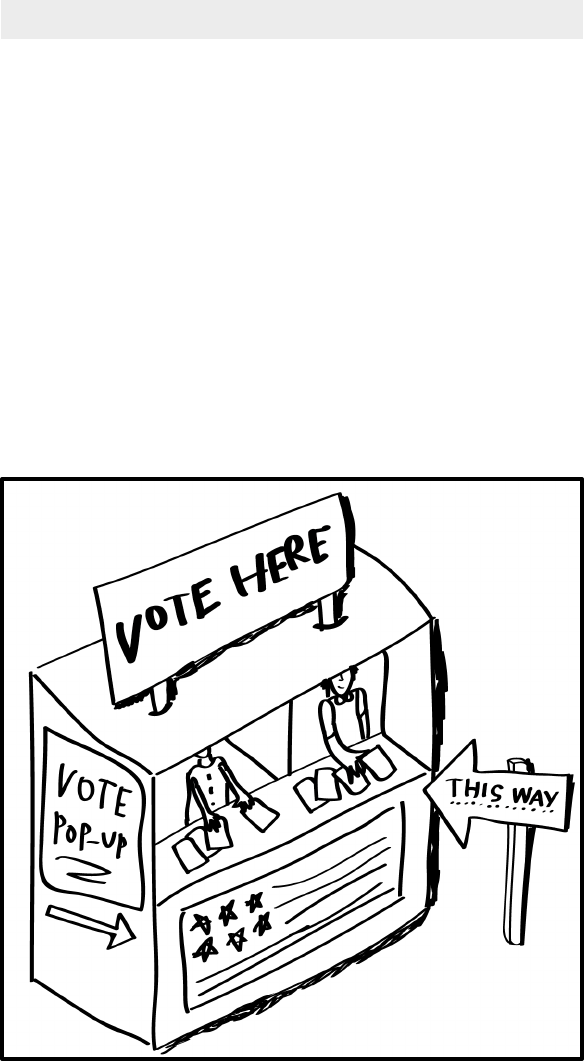
43. Pop-up polling places
Problem: Getting to new places can be hard for people
with a variety of disabilities.
Idea: A pop-up polling place could be located anywhere,
such as transit stations, parking lots, or the lobby of a
building. With a small footprint, they can be located in
places where voters already go. Popup polling places
could also be moved to serve multiple locations during
early voting periods.
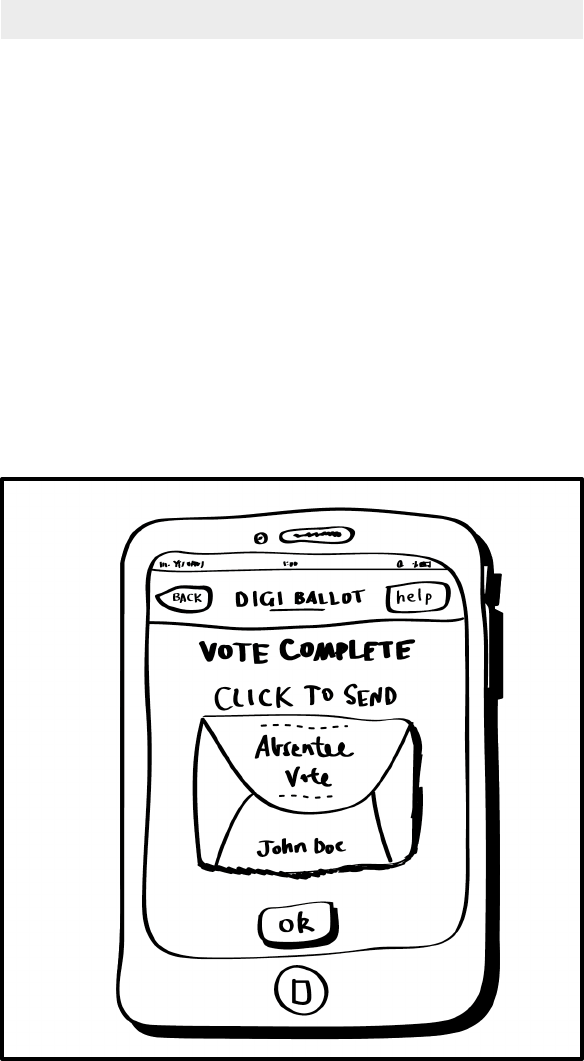
44. Mail an absentee voting device
Problem: Some voters need to vote with an accessible
absentee ballot from their home. However, even if the
ballot is provided to them electronically, they may not be
able to use it if they do not have a personal computer
with the necessary accessibility features, such as a
screen reader.
Idea: Instead of relying on voters having their own
personal computers, election officials could provide a
mobile absentee voting device directly to voters. Voters
could receive this device in the mail, mark their ballots,
and then return it to the election office.
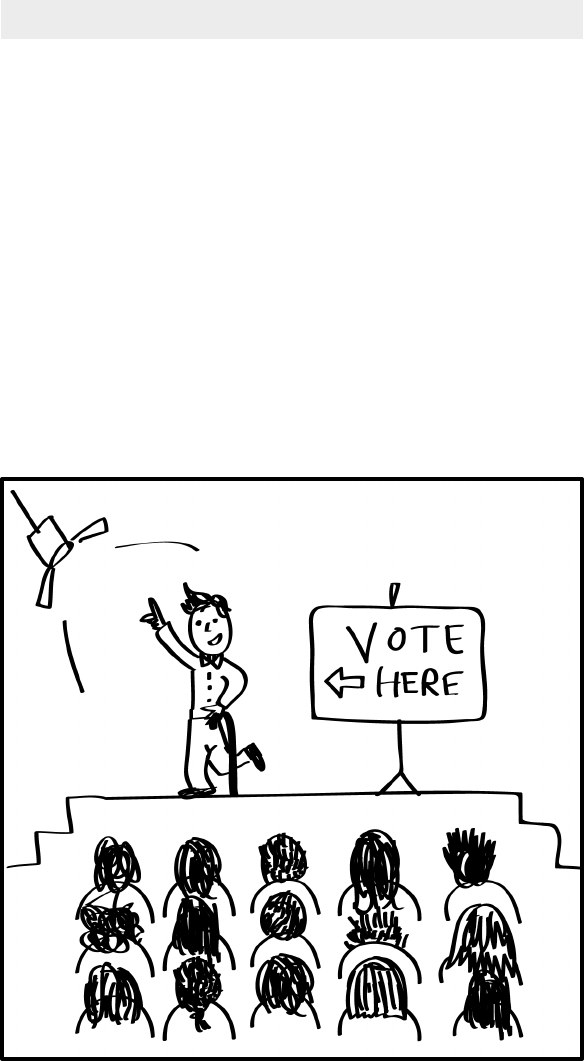
45. Tell a story. Enact a scene.
Problem: Since some poll workers do not have enough
experience interacting with voters with disabilities, they
may be uncomfortable or afraid that they will say the
wrong thing. This may lead to a poor experience at the
polling place for voters.
Idea: Election officials could use role-playing games to
educate poll workers on how to interact with voters with
disabilities. Videos with scenes that show good practices
could support in-person training sessions. Enabling poll
workers to practice typical scenarios in advance could
make helping voters on Election Day go more smoothly.

46. Barcodes to transfer voting choices
Problem: Some accessible voting systems allow voters to
mark their ballots and then bring the completed ballot to
a scanner to cast their ballot. However, voters who do
not have the use of their hands or who cannot see the
ballot may need assistance which reduces their
independence and privacy.
Idea: Ballot selections could be both portable and private
for everyone if they were embedded in a two-dimensional
barcode (e.g. a QR code). Voters could scan and verify
their selections using their own mobile device or a
scanner provided by the election office, much like an
electronic airline boarding pass.
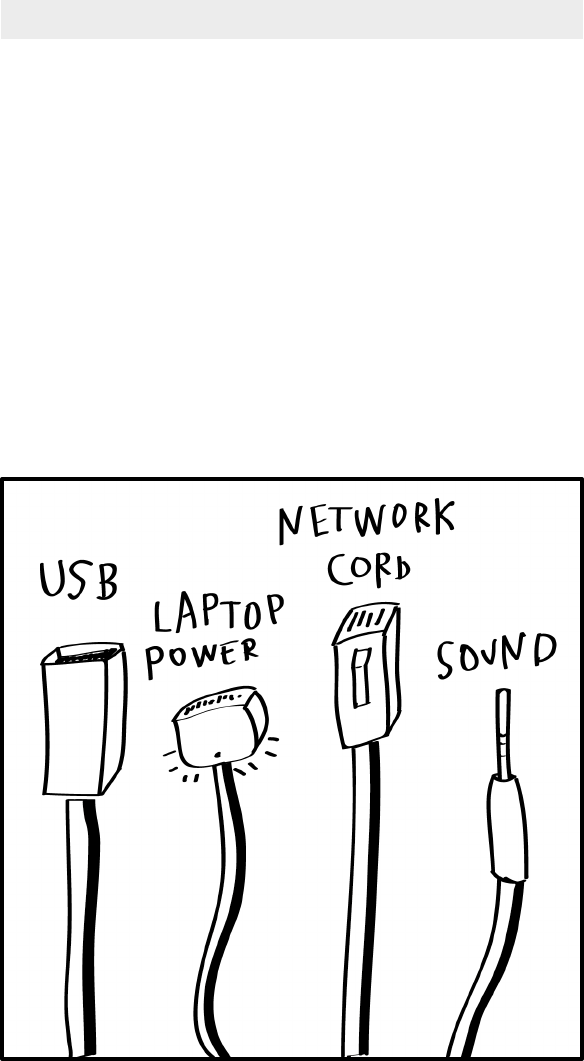
47. Standards for assistive devices
Problem: There are no universal standards for connecting
specialized keyboards and communication devices to
voting systems. This makes it hard for voters who rely on
specialized devices to use the technology they are
already familiar with to vote.
Idea: Universal communications standards, both for the
hardware and the ballot, would make it possible to
connect personal assistive technology to voting systems,
and use it to vote.
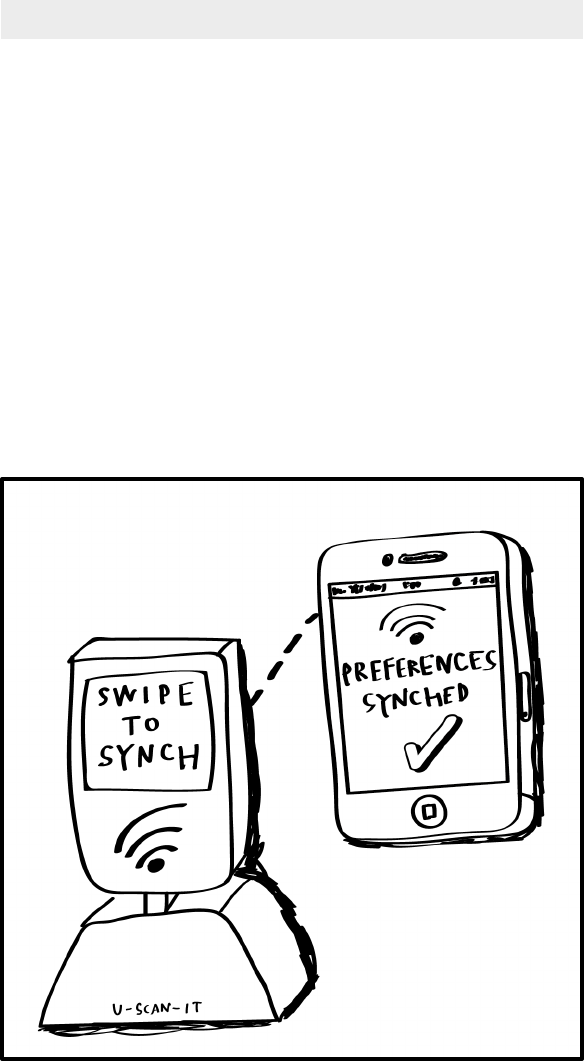
48. Tap it to configure it
Problem: Some voting systems have many accessibility
features, but it may be difficult to setup these
personalized options for each voter or for the voter to
remember which settings are useful.
Idea: Using a mobile app on their own mobile devices,
voters with disabilities could select the accessibility
features they would like to use at the polling place. Then
voting systems could be designed so that voters could use
Near Field Communication (NFC) to quickly “tap” the
voting system and automatically have it configured to
their personal preferences.
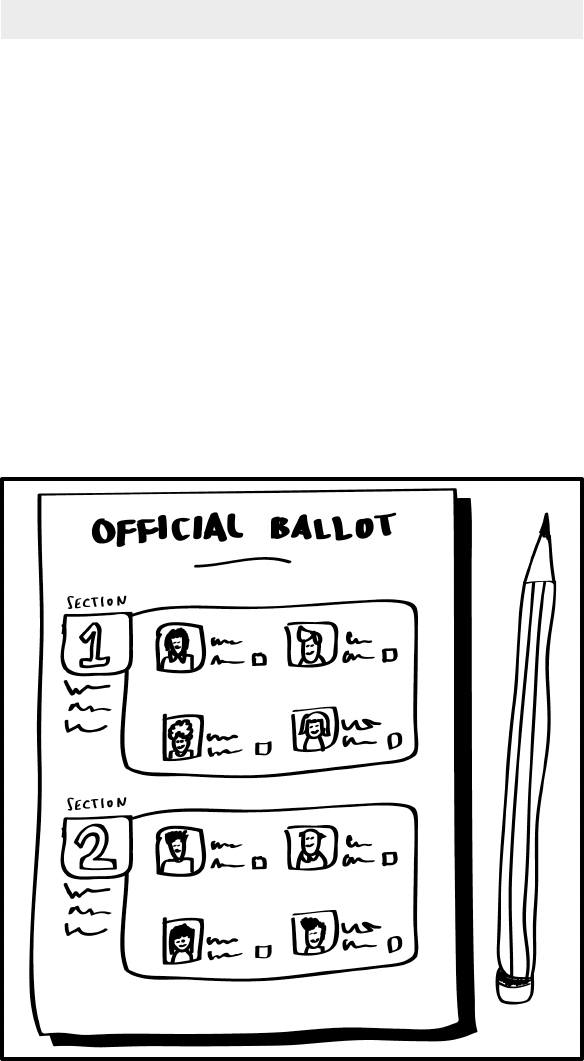
49. Simplify the interaction
Problem: Ballots are often complex and designed for
visual access. When they are converted into an audio
ballot for non-visual access, they are can be difficult or
slow to use.
Idea: Voting system and ballot designers should aim for
simplicity in how the ballot is presented and navigated,
so the ballots are accessible for as wide a range of voters
as possible. For example, ballots could be broken into
intuitive, manageable chunks by clearly separating
contests for different levels of government.
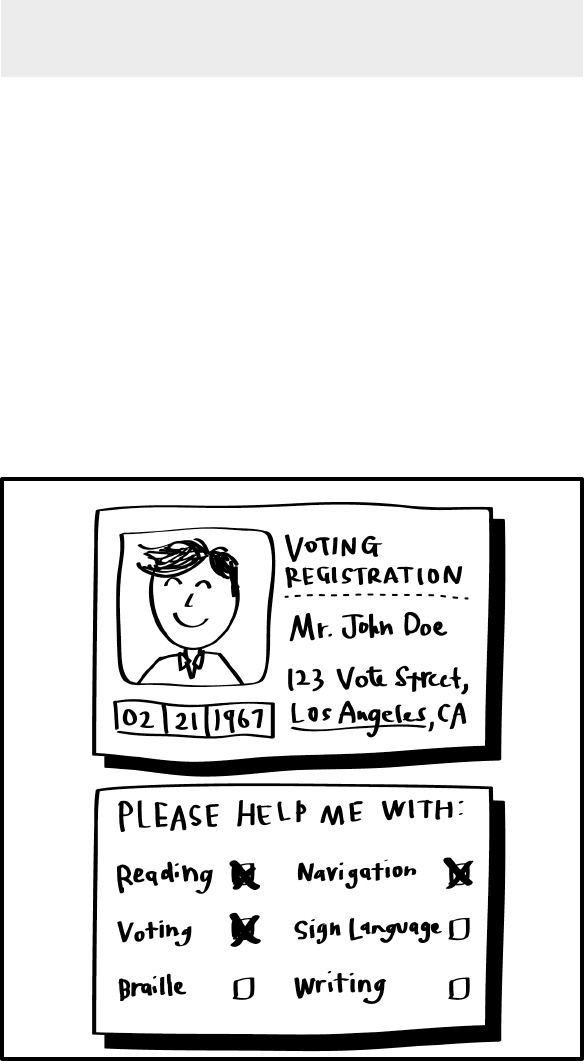
50. Preferences on voter registration
cards
Problem: Voters with disabilities do not have an easy
way to tell poll workers what ballot format or other
assistance they need. This sometimes forces them to
announce their disability publicly, even if they prefer it to
be private.
Idea: Instead of making voters announce their
disabilities, or forcing poll workers to guess, election
officials could include voter preferences for elections
information, ballot format, and language on the voter
registration card.
Acknowledgements
This project could not have been completed without the
creative input and hard work from the participants of the
innovation challenge run by OpenIDEO and the design
workshops hosted by the Georgia Tech Center for
Assistive Technology and Environmental Access (CATEA).
In addition, a special thanks to Whitney Quesenbery for
helping to draft this report, Sharon Laskowski and Shanee
Dawkins for providing feedback and suggestions, and
Samantha Curcio for illustrating each concept.
About ITIF
The Information Technology and Innovation Foundation
(ITIF) is a Washington, D.C.-based think-tank at the
cutting edge of designing innovation strategies and
technology policies to create economic opportunities and
improve quality of life in the United States and around the
world. Founded in 2006, ITIF is a 501(c)3 nonprofit, non-
partisan organization that provides pragmatic ideas for
improving technology-driven productivity, boosting
competitiveness, and meeting today’s global challenges
through innovation.
Contact
For more information about the ITIF Accessible Voting
Technology Initiative, please visit http://elections.itif.org
or contact Daniel Castro by email at [email protected] or by
phone at 202-449-1351.
